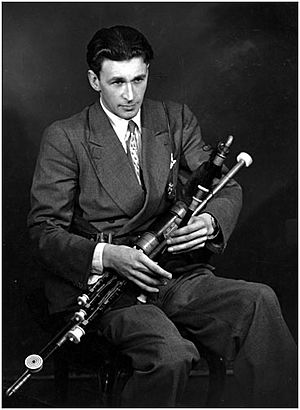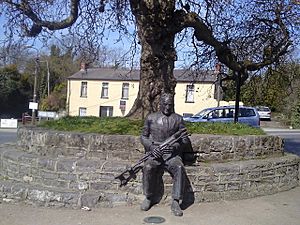Séamus Ennis facts for kids
Quick facts for kids
Séamus Ennis
|
|
|---|---|

Ennis in 1955
|
|
| Background information | |
| Birth name | Séamus Ennis |
| Born | 5 May 1919 Finglas, Dublin, Ireland |
| Died | 5 October 1982 (aged 63) Naul, County Dublin, Ireland |
| Genres | Irish Traditional Music |
| Occupation(s) | Musician, Singer, Irish music collector |
| Instruments | Uilleann pipes, tin whistle, fiddle, vocals |
| Years active | 1958–1982 |
| Labels | Tradition, Green Linnet, Claddagh |
| Associated acts | The Halfpenny Bridge Quartet |
| Past members | Liam O'Flynn Sonny Brogan Seán Keane |
Séamus Ennis (Irish: Séamas Mac Aonghusa; 5 May 1919 – 5 October 1982) was a famous Irish musician and singer. He was also a special kind of music collector. Séamus was best known for playing the uilleann pipes, a traditional Irish instrument. He helped bring this instrument back to popularity in the 1900s.
He even helped start Na Píobairí Uilleann, a group that promotes uilleann pipes. Séamus is famous for saving almost 2,000 Irish songs and dance tunes. He collected these as part of his work with the Irish Folklore Commission. Many people think Séamus Ennis was one of the best uilleann pipers ever.
Contents
Early Life and Musical Roots
Séamus Ennis was born on May 5, 1919, in Jamestown, Finglas, North Dublin City. His father, James Ennis, worked for the Irish civil service. James was also a talented musician. In 1908, he bought parts of an old set of uilleann pipes in London.
These pipes were made in the mid-1800s in Dublin. James Ennis won awards for playing the uilleann pipes. He was also a great dancer. In 1916, he married Mary Josephine McCabe, who was a skilled fiddle player.
Séamus was one of their six children. When Séamus was thirteen, his father started teaching him to play the pipes. Séamus went to schools where he learned the Irish language. This skill was very helpful later in his life.
Starting His Career
After school, Séamus was 20 and looking for a job. A family friend, Colm Ó Lochlainn, offered him work. Colm was the editor of Irish Street Ballads. In 1938, Séamus began working at The Three Candles Press.
There, he learned how to print books. He also learned how to write down music, which was a very important skill. In 1942, during a time of shortages in Ireland, things became tough for printers. Professor Seamus Ó Duilearge then hired Séamus.
Séamus was 23 years old. His new job was to travel around Ireland and collect old songs. He was given a pen, paper, a bicycle, and a small salary. He started his journey in Connemara.
Becoming a Song Collector
From 1942 to 1947, Séamus worked for the Irish Folklore Commission. He traveled across many counties in Ireland. He collected songs in places like west Munster, Galway, Cavan, and the Aran Islands. He even went to the Scottish Hebrides.
Séamus knew Scots Gaelic, which helped him write down many songs. He was very good at connecting with the musicians and singers he met. In 1947, he started working for Raidió Éireann (Irish radio). He presented shows and recorded famous musicians for the first time.
In 1951, two American music collectors, Alan Lomax and Jean Ritchie, came to Ireland. They recorded Irish songs and tunes. This time, Séamus was the one being recorded! There is a famous photo from 1952 or 1953. It shows Jean listening to the tape recorder while Séamus plays his uilleann pipes.
Working with the BBC
In late 1951, Séamus joined the BBC in London. He worked with a producer named Brian George. In 1952, he married Margaret Glynn. They had two children, Catherine and Christopher. His job was to record traditional music from England, Scotland, Wales, and Ireland.
He presented this music on a BBC radio show called As I Roved Out. The show ran until 1958. Séamus also worked with Alan Lomax again. He helped create an album of Irish folk music for Columbia Records.
A Full-Time Musician's Journey
In 1958, Séamus became a freelance musician. He worked in England and then returned to Ireland. He started working for the new TV station, Teilifis Éireann. Soon, he was making his living entirely from his music.
Around this time, his marriage ended, and he moved back to Ireland. He also became ill with tuberculosis. In 1964, he performed at the Newport Folk Festival in the United States. His father gave him the special pipes he had bought in 1908.
Séamus was a master at playing slow, beautiful tunes called "slow airs." He knew how to add small, tasteful decorations to his music. He could make long notes sound even more special.
Two famous events are still talked about among pipers. One was in Bettystown in 1968. This is where the society for Irish pipers, Na Píobairí Uilleann, was formed. Séamus played his 130-year-old pipes for over an hour. He even let other famous pipers play his precious instrument.
Another unforgettable music session happened in Dowlings' pub in Prosperous, County Kildare. Many future members of the famous band Planxty were there. Séamus never ran a piping school. But his passion for music inspired everyone he met.
In the early 1970s, he lived with Liam O'Flynn for almost three years. Later, he bought land in Naul and lived in a mobile home. One of his last performances was at the Willie Clancy Summer School in 1982. He passed away on October 5, 1982. He left his pipes to Liam O'Flynn.
Remembering Séamus Ennis

A road in his hometown of Finglas is named Séamus Ennis Road to honor him. The Séamus Ennis Arts Centre in Naul was also opened in his memory. It celebrates his work and promotes traditional arts.
The famous musician Christy Moore wrote a song about him called 'The Easter Snow.' This is the name of a slow tune Séamus used to play. It was also the name he gave to his last home in Naul.
Music Albums
Here are some of the albums Séamus Ennis released:
- The Bonny Bunch of Roses (1957)
- The Ace and Deuce of Piping (1961)
- Forty Years of Irish Piping (1974)
- The Pure Drop (1974)
- The Fox Chase (1974)
- The Best of Irish Piping (1974)
- Irish Pipe and Tin Whistle Songs (1976)
- Feidhlim Tonn Rí's Castle (1977)
- The Wandering Minstrel (1977)
- Forty Years of Irish Piping (1977)
- The Return from Fingal (1997)
- Two Centuries of Celtic Music (2001)
- Séamus Ennis – Ceol, Scéalta agus Amhráin (2006)
Music Collections with Other Artists
Séamus Ennis's music also appeared on these collections:
- Irish Pipe and Tin Whistle Songs (1994)
- Green Linnet 20th Anniversary Collection (1996)
- Alan Lomax Sampler (1997)
- Traditional Dance Music of Ireland (1997)
In 2009, his song The Blackbird was part of a special 70-year anniversary music set.
See also
- List of Irish music collectors

